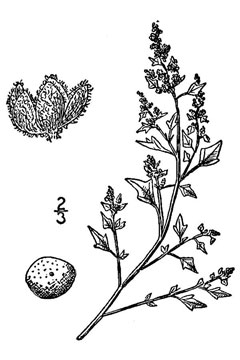
Mealy Goosefoot
Latin Name: Chenopodium incanum
USDA Hardiness: Coming soon
Native Range: NORTHERN AMERICA: Canada (Alberta (southeast), Saskatchewan (southwest)), United States (Kansas (west), Nebraska, Oklahoma (west), South Dakota, Colorado, Wyoming (southeast), New Mexico, Texas (west), Arizona, California (east), Nevada, Utah (south))
Edibility Rating: 2 / 5
Medicinal Rating: 0 / 5
Region:
Family:
Plant Type:
Medicinal Uses
Edible Uses
Edible Parts: Leaves Seed Shoots | Edible Uses: Leaves and young shoots - cooked and eaten like spinach[85, 216, 257]. The raw leaves should only be eaten in small quantities, see the notes above on toxicity. Seed - cooked. It can be ground into a powder and mixed with wheat or other cereals in making bread etc[85, 257]. The seed is small and fiddly, about 1mm in diameter[270], it should be soaked in water overnight and thoroughly rinsed before it is used in order to remove any saponins.
Cultivation
We have very little information on this species and do not know how well it will grow in Britain, but it should succeed as a spring sown annual. The following notes are based on the general needs of the genus. An easily grown plant, succeeding in most soils but disliking shade[1, 200]. It prefers a moderately fertile soil[200].
Known Hazards
The leaves and seeds of all members of this genus are more or less edible. However, many of the species in this genus contain saponins, though usually in quantities too small to do any harm. Although toxic, saponins are poorly absorbed by the body and most pass straight through without any problem. They are also broken down to a large extent in the cooking process. Saponins are found in many foods, such as some beans. Saponins are much more toxic to some creatures, such as fish, and hunting tribes have traditionally put large quantities of them in streams, lakes etc in order to stupefy or kill the fish[K]. The plants also contain some oxalic acid, which in large quantities can lock up some of the nutrients in the food. However, even considering this, they are very nutritious vegetables in reasonable quantities. Cooking the plants will reduce their content of oxalic acid. People with a tendency to rheumatism, arthritis, gout, kidney stones or hyperacidity should take especial caution if including this plant in their diet since it can aggravate their condition[238].
Habitats
Dry soils[235] in waste ground[43]. Sandy soils and hills, limestone and gypsiferous soils, waste areas at elevations of 500 - 2500 metres[270].
